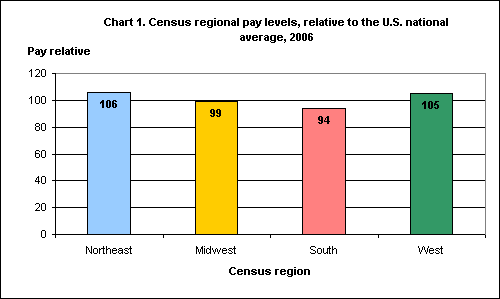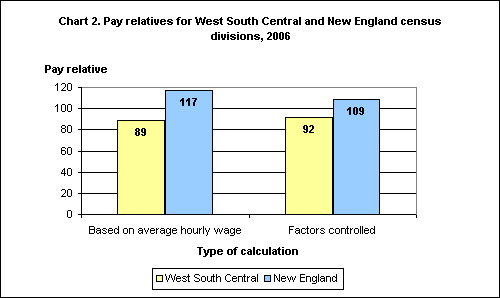Pay Relatives for U.S. Census Regions and Divisions, 2006
Originally Posted: August 28, 2008 Results from the 2006 National Compensation Survey show that average pay levels in the Northeast and West are higher than in the South and Midwest. The National Compensation Survey (NCS) provides national, regional, and locality estimates of occupational wage rates in the civilian sector of the United States.1 To simplify comparisons of pay levels among localities and regions, the NCS publishes pay relatives. A pay relative is a calculation of earnings--wages, salaries, commissions, and production bonuses--for a given geographic area relative to the Nation as a whole.2 The calculation of pay relatives among localities controls for differences in occupational composition, establishment and job characteristics, and the fact that locality data are collected at different times throughout the year. The NCS has produced national pay relatives for selected localities annually since 2004. This article presents pay relatives for the four census regions and the census divisions within those regions. The pay relatives are calculated for all civilian workers and for each of nine major occupation groups. The article emphasizes the importance of the statistical significance of the numbers used for comparisons among geographic areas. It also discusses some of the possible consequences of making simple wage comparisons among geographic areas using only published average hourly earnings. The U.S. Census Bureau defines four regions in the United States--the Northeast, the South, the Midwest, and the West. Census divisions are subsets of the census regions; for example, the Northeast region includes two divisions: New England and Middle Atlantic. (See appendix for a complete list of the census regions and divisions and the States contained in them.) The national pay relative is set at 100, and regional and divisional pay relatives are calculated in relation to this figure. Chart 1 shows the pay relatives for each of the four census regions3:  Data considerationsNCS pay relatives are estimated using a multivariate regression technique to control for geographic differences in the following:
Simple pay comparisons can be calculated using the published wage averages of census regions and census divisions.4 However, estimates that do not control for the factors listed above can be misleading.5 For example, the published average earnings for all workers in the West South Central and New England census divisions were $17.12 and $22.54, respectively. As chart 2 shows, when averages such as these are used to produce simple pay comparisons based only on their differences from the published U.S. estimate, the implied result can either overestimate or underestimate the actual differences among areas6:  Note that average pay in the West South Central division is only 76 percent of average pay in New England (89 ÷ 117). By contrast, when differences in factors among the areas are controlled for in the calculation, the pay for West South Central is 84 percent of that of New England (92 ÷ 109). Pay relatives among census regions and divisionsTable 1 shows the pay relatives for each major occupational group by census region and division:
The pay relatives were tested at the 10-percent level of statistical significance to determine if each, despite its value, is significantly different statistically from the national average of 100. Those pay relatives with an asterisk (*) next to the value were found to be significantly different from the national average. In the South region and its three constituent divisions--South Atlantic, East South Central, and West South Central--almost all of the pay relatives for the nine major occupational groups were less than the pay relative for the Nation as a whole. Production and transportation and material moving occupational groups in the South Atlantic division, while less than 100, were not significantly different than the national average. By contrast, almost all of the pay relatives for occupational groups in the Northeast region and its two census divisions--New England and Middle Atlantic--were higher than the national average. With a pay relative of 101, production workers in the Middle Atlantic division were not paid significantly differently from the national average. On the other hand, all of the pay relatives in the West region and its Pacific division were significantly above the national average. In the West's Mountain division, however, only installation, maintenance, and repair occupations had pay relatives significantly greater than the national average. Distribution of pay relatives within census regions and divisionsAlthough regions and divisions that are high paying in one major occupation group tend to be high paying in others, there are differences in pay relatives within such geographic areas. For example, in the Northeast census region, pay relatives ranged from 113 for the construction and extraction occupations to 102 for production occupations. Similarly, pay relatives in the Northeast's Middle Atlantic division ranged from 101 for production occupations to 112 for construction and extraction occupations. By contrast, in the East South Central division, pay relatives ranged only from 92 percent of the national average for the professional and related occupations to 96 percent for construction and extraction occupations. Although occupational groups in the South region and its three divisions had no pay relatives above the national average that were significantly different from the national average7, there were pay relatives greater than 100 in several metropolitan areas within the South. For example, the Washington, DC, metropolitan area had pay relatives significantly higher than the national average for several major occupational groups. Area-to-national pay relatives for the nine major occupational groups in 78 individual areas can be found at http://www.bls.gov/ncs/ocs/payrel.htm#National. Area-to-area pay relatives are available at http://www.bls.gov/ncs/ocs/payrel.htm. Appendix. Distribution of states by census region and division
Acknowledgement: The author would like to thank Lowell Mason of the Office of Compensation and Working Conditions for preparing special data tabulations for this article. Notes1 For the National Compensation Survey (NCS), the civilian sector includes workers in private industry and in State and local government. This excludes Federal government, agricultural, and household workers. 2 See Occupational Pay Relatives, 2004, USDL 05-2382 (U.S. Department of Labor), December 28, 2005; available on the Internet at http://www.bls.gov/ncs/ocs/sp/ncnr0002.pdf. 3 These percentages do not average to 100 because each region is weighted differently. 4 The latest NCS data on occupational wages in each of the nine census divisions can be found on the Internet at http://www.bls.gov/ncs/ocs/compub.htm#Division. 5 See Maury B. Gittleman, "Pay relatives for metropolitan areas in the NCS," Monthly Labor Review, March 2005, pp. 46-53; available on the Internet at http://www.bls.gov/opub/mlr/2005/03/art4full.pdf. 6 The simple pay comparisons based on published hourly rates were produced by dividing the average hourly pay for the West South Central ($17.12) and the New England division ($22.54) by the U.S. average ($19.29). Multiply the results by 100 and round to the whole number. These averages produce simple pay comparisons of 117 and 89 for the New England and the West South Central divisions, respectively. For example, calculations for the West South Central division are as follows: $17.12 divided by $19.29 equals 0.8875; multiply 0.8875 by 100 and round to the nearest whole number, 0.89. Dividing the West South Central simple pay comparison (89) by the New England simple pay comparison (117) shows that the West South Central's average hourly earnings were about 76 percent of New England's average. 7 Only production occupations and transportation and material moving occupations in the South Atlantic division had pay relatives of 99, and these were not significantly different from the national average. 8 The Middle Atlantic census division also includes the New York, NY, Consolidated Metropolitan Statistical Area (which comprises parts of New York, New Jersey, Connecticut, and Pennsylvania), and the Philadelphia, PA, Consolidated Metropolitan Statistical Area (which comprises parts of Pennsylvania, New Jersey, Delaware, and Maryland). 9 The East North Central census division also includes the Cincinnati, OH, Consolidated Metropolitan Statistical Area (which comprises parts of Ohio, Kentucky, and Indiana). 10 The West North Central census division also includes the St. Louis, MO, Metropolitan Statistical Area (which comprises parts of Missouri and Illinois), and the Minneapolis-St. Paul, MN, Metropolitan Statistical Area (which comprises parts of Minnesota and Wisconsin). 11 The East South Central census division also includes the Louisville, KY, Metropolitan Statistical Area (which comprises parts of Kentucky and Indiana), and the Memphis, TN, Metropolitan Statistical Area (which comprises parts of Tennessee, Arkansas, and Mississippi).
|
|||||||||||||||||||||||||||||||||||||||||||||||||||||||||||||||||||||||||||||||||||||||||||||||||||||||||||||||||||||||||||||||||||||||||||||||||||||||||||||||||||||||||||||||||||||||||||||||||
Tools |
Calculators |
Help |
Info |